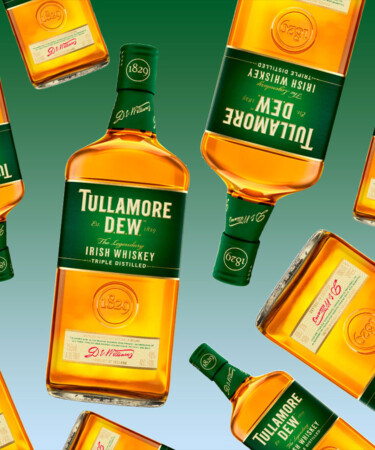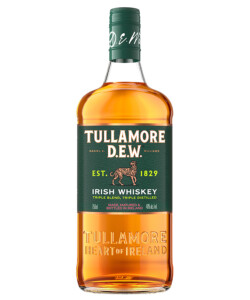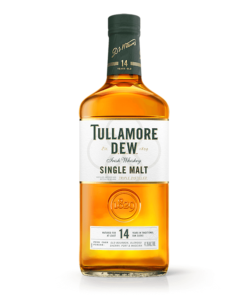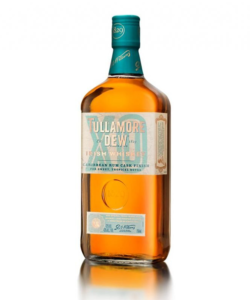When the Old Tullamore Distillery opened its doors in 1829, it was the most landlocked distillery in all of Ireland. Despite this, production soared in the 1800s and early 1900s and the label was even able to hold on during the massive decline in Irish whiskey sales during the latter half of the 1900s. This would be the beginning of Tullamore D.E.W.
With a brand-new distillery and visitors center constructed just over 10 years ago, Tullamore D.E.W. is working to return Ireland’s whiskey to its former glory. Today, the brand is the second most popular Irish whiskey in the world, doling out an average 10 shots per second every day. Here are 10 more things you should know about the historic blended Irish whiskey.
At Tullamore D.E.W., it’s all about the rule of threes.
Tullamore D.E.W. prides itself on its complex yet approachable flavors, which it credits to its use of three types of grain, a triple distillation, and the blending of three types of Irish whiskey — single malt, single grain, and pot still. Of the multitude of blended Irish whiskies on the market today, Tullamore D.E.W. was the very first to pioneer a triple blend Irish whiskey. According to Brian Kinsman, master blender at William Grant, grain whiskey works to bring in crisp, green notes and single malt brings fruit essences, while pot still whiskey rounds out the flavor profile by balancing the whiskey with slightly spiced notes. To further the whiskey’s connection to the number three, each batch is aged in three different casks: bourbon, sherry, and refill casks.
Despite the green bottle, the “DEW” doesn’t allude to dew on the grass.
Many whiskey brands that pride themselves on their grassy, vegetal notes often choose to associate these flavors with a green label. Given this typical association, it’s easy to assume that the “dew” in Tullamore D.E.W. refers to the dew found on grass in the early morning. However, the name is actually an ode to Daniel Edmund Williams, who began working at the Old Tullamore distillery as a stable boy when he was just 15 years old. Within just 10 years, he had worked his way up to distillery manager. When the Malloy brothers — who opened the distillery — both passed, ownership was left to Captain Bernard Daly, the brother’s nephew, but the running of the distillery was left to Williams alone, who went on to become one of the country’s most beloved distillers of all time.
Daniel E. Williams brought technological advancements to the town of Tullamore.
During his time serving as distillery manager, Williams was the first to bring electricity to the town of Tullamore, in 1893. Additionally, Williams was the first to install a telephone in the town of Tullamore when he installed one to be used in the distillery, and he brought the first method of motorized transport to the town when he implemented the use of a delivery truck. Beyond serving as the distillery’s general manager, Williams also had businesses importing tea, retailing seeds and grains, and owned a network of 26 general stores.
The whiskey wasn’t always called Tullamore D.E.W.
When Williams worked at the Old Tullamore distillery, the whiskey was not yet going by the name Tullamore D.E.W. Instead, it was known to the people of the U.K. as Daly’s Whiskey, in reference to owner Captain Bernard. According to Alfred Barnard in his book “Whisky Distilleries of the United Kingdom,” Daly’s Whiskey was sold across Ireland, though principally in Dublin, “whilst a large quantity goes to Liverpool, London, and Australia.” Following Daly’s passing and Daniel E. Williams’ death in 1921, Williams’ family came to own the distillery and shortly thereafter renamed the whiskey in his honor. Now, his initials D.E.W. live on each and every bottle that emerges from the distillery.
It was the original Irish whiskey used in Irish Coffee.
Despite the fact that Jameson may be the bottle most bartenders reach for first when making an Irish Coffee, it was actually Tullamore D.E.W. that was used in the cocktail’s very first iteration. The famous drink was first whipped up at Ireland’s Shannon Airport in 1952, which became the only place in the whole world where it could be enjoyed. But as more Americans moved through the airport and tried the cocktail for themselves, they quickly found ways to bring the beverage home with them. Among these American travelers was Stanton Delaplane, a travel writer tasked with recreating the beverage on American soil by the bar team at San Francisco’s beloved The Buena Vista. The effort failed on numerous attempts, prompting Delaplane and the bar team to take the issue to George Christopher, a dairy farmer who also happened to be the city’s mayor. Together, they devised a plan to make the perfect Irish Coffee float from cream that had been aged for 48 hours, and at last they were successful. To this day, Tullamore D.E.W. is still used in the original Irish Coffee recipe at The Buena Vista.
In 1954, production of Tullamore D.E.W. was moved away from its original home.
In the mid-1950s, ownership and control of the distillery was passed to Williams’ granddaughter Teresa (wife to Frank O’Reilley of Powers Whiskey), who made the decision to shutter Tullamore D.E.W.’s original distillery. Following Ireland achieving independence in 1922, the category of Irish whiskey struggled to retain demand, with sales slipping even further when the United States enacted Prohibition. By 1954, the category had been on the brink of becoming obsolete for decades. In response to the decrease in sales and production, O’Reilley made the decision to move production of the whiskey to Dublin, where it remained until 1966 before relocating again to Cork following the formation of Irish Distillers Limited. The company was formed in response to the decreasing demand for the spirit that was once the most popular in the world and, at one point, held a complete monopoly over Irish whiskey production.
Production of the beloved whiskey returned home to Tullamore in 2014.
When Tullamore D.E.W. was purchased by William Grant & Sons in 2010, the first order of business was constructing a visitors center for whiskey lovers to experience all that Tullamore had to offer. As such, the company immediately took to building one on the same grounds where the Old Tullamore distillery once stood, and a new, state-of-the-art distillery just a stone’s throw away. Production began at the new distillery in September 2014, and just one year later, production capacity doubled to reach a whopping 3.6 million liters per year. Three years later, the distillery added its very own grain distillery and bottling hall to the grounds for a whopping 100 million euros.
At the distillery, visitors can enjoy a drink in a bar hidden among whiskey barrels…
At the distillery, drinkers have the unique pleasure of enjoying a drink in Tullamore D.E.W.’s maturation warehouse. However, unlike other distillery tours where a tasting may be conducted among the barrels, visitors of Tullamore are welcomed into Ireland’s only custom-built warehouse snug dubbed “the Secret Snug.” While in the snug, they’re encouraged to “dip the dog” and enjoy a pour of whiskey delivered fresh from the cask while surrounded by 365,000 full barrels.
…and take home a bottle of their personally blended whiskey.
After exiting the Secret Snug, visitors are ushered down to the production line where they are able to bottle their own Irish whiskey. There, they have the chance to blend their own version of the Irish whiskey. As part of the “Be the Blender” experience, each visitor is prompted to blend and bottle their own unique whiskey that they can then purchase and take home with them. While other distilleries may provide personalized engraved bottles for each of their visitors, Tullamore D.E.W. is the only in the world providing this specific experience.
There are seven expressions to try under the Tullamore D.E.W. umbrella.
In addition to the flagship Tullamore D.E.W. Original Irish Whiskey, the brand also offers six expressions for enthusiasts to sample. These releases include 12 Year Old Special Reserve that ages in a combination of bourbon and sherry casks, the XO Caribbean Rum Cask Finish aged in barrels previously used for Demerara rum, and both a 14 Year Old and 18 Year Old Single Malt. Additionally, the brand offers two select-release Irish whiskies, including the Old Bonded Warehouse Release, which is exclusively available for purchase at the visitor center and the Cider Cask Finish, which carries notes of toasted oak and cider sweetness and is only available in select markets.



